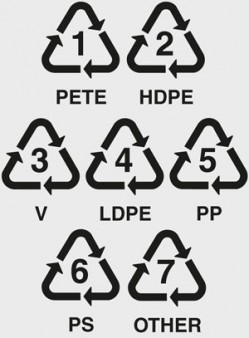Number 1. Plastics found in the category include soft drink, water, and some beer and other drink bottles. In some cases, the food trays that sometimes come with convenience foods can be used as well. Most of these plastics are marked with a 1 inside the recycling symbol on the bottom of the container. These plastics can be recycled in used in products like carpets and fiberfill for an assortment of jackets, coats, or even sleeping bags.
Number 2 on the list of plastic recycling numbers refers to such plastic products as laundry detergent bottles and containers. Milk jugs classify as well. As long as the plastic of this type is clear, it can be recycled. It often finds new life as plastic lumber. That is the material that is typically found in children’s outdoor play sets, but it can also be used for faux wood decks as well.
At this point in the plastic recycling numbers, things start to get a bit harder to recycle. Number 3 plastics consist of things like plumbing piping and clear food packaging. Most common plastic recycling centers aren’t going to be able to recycle these. As a consumer you can choose to avoid buying products containing number 3 plastics. Number four plastics are virtually impossible to recycle as well. These bags are used for frozen foods and other grocery items. Its not that they cant be recycled. They are so lightweight that it takes more gas and energy to transport them to the recycling center than it does to make virgin plastic bags of this type. Until that changes, number four plastics will continue to go to the landfills.
As a general rule, the higher the plastic recycling numbers, the less likely the items are to be recyclable. When you are putting your recycling together for collection, be sure to double check your numbers.
http://www.recyclingfactsguide.com/plastic-recycling-numbers/



